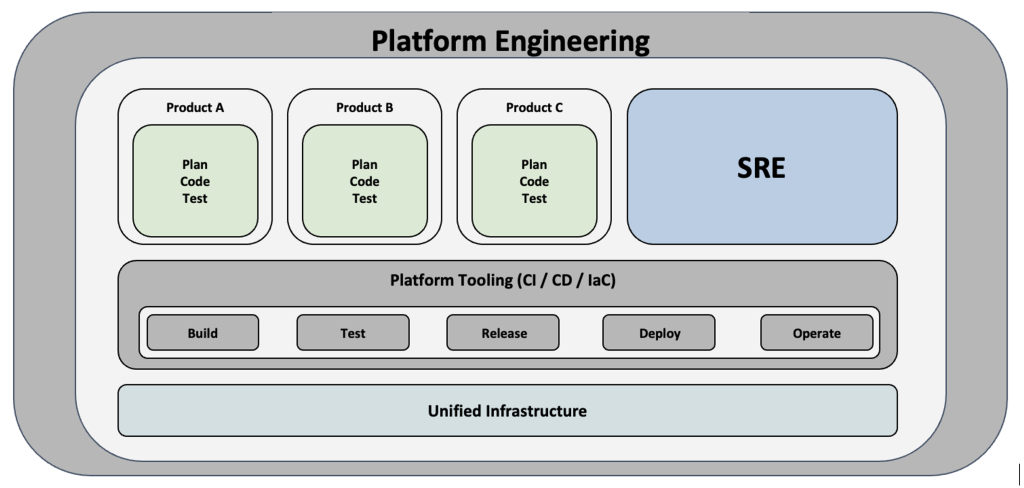What is an Internal Developer Platform (IDP)?
After having introduced Internal Developer Platform in our first blog post of this series, we want to talk about the features of an IDP in more details and write why IDPs matters for companies within a cloud transformation.
First, the concept of an IDP basically consists of three main components:
Firstly, „Internal“ signifies that the platform is designed for use exclusively within an organization. Unlike public or open-source tools, an IDP is tailored to meet the specific requirements and security standards of the company. This focus ensures that internal workflows, data, and processes remain secure and optimized for the company’s unique ecosystem.
Secondly, the „Developer“ component highlights that the primary users of these platforms are the application developers within the organization. The platform is designed with the needs of developers in mind, aiming to streamline their workflows, improve efficiency, and enhance productivity. By centralizing tools and resources, an IDP reduces the complexity developers face, allowing them to focus more on coding and less on administrative or setup tasks.
Thirdly, „Platform“ denotes that the IDP serves as a foundational framework combining various development, deployment, and operational tools into a cohesive environment. This includes integration with version control systems, continuous integration (CI) tools, GitOps practices, databases, and container technologies. By bringing these elements together, the platform facilitates a more streamlined and coherent development lifecycle.
The main objective of an IDP is to simplify and enhance the developer experience by automating processes, centralizing resources, and eliminating unnecessary manual tasks. This includes enabling developers to request resources, initiate pre-provisioned environments, deploy applications, and manage deployments with greater ease and efficiency. As a result, the deployment process, in addition to development, becomes part of the developer’s realm, increasing control and agility.
An IDP typically requires only a coding environment, the Git tool for version control and merging, and the platform itself. This consolidation reduces the need for external websites or the creation of superfluous scripts to execute certain processes or actions, thereby streamlining the entire application development process.
Internal Developer Platforms are generally developed by a dedicated in-house team, known as the Platform Developer Team, which ensures that the platform is customized to fit the company’s needs and goals. However, for companies lacking the resources or expertise to develop their own IDP, there are Platform-as-a-Service (PaaS) options available, providing a complete, out-of-the-box solution from various vendors.
In contrast to IDPs, the term „Internal Developer Portal“ is occasionally mentioned in literature. While it can be used interchangeably with IDP in some contexts, most sources differentiate between the two. The Internal Developer Portal is typically understood as the graphical user interface (GUI) of the IDP, through which developers and sometimes automated systems interact with the platform’s tools and services. This interface simplifies the user experience, making the platform’s functionality more accessible and intuitive.
The Importance of Self-Service
The concept of self-service is a crucial aspect of Internal Developer Platforms (IDP) and significantly enhances their value and utility for developers. Self-service mechanisms within an IDP empower developers by giving them the autonomy to access resources, tools, and environments directly, without needing to wait for approval or intervention from IT operations or other departments. This approach accelerates workflows, promotes efficiency, and reduces bottlenecks in the development cycle.
In a self-service oriented IDP, developers can perform a variety of actions independently. For example, they can request and allocate computational resources, initiate pre-configured environments, deploy applications, and set up automated deployments. Additionally, they can manage scaling, monitor performance, and if necessary, roll back to previous versions of their applications without external assistance. This autonomy not only speeds up the development process but also encourages experimentation and innovation as developers can try out new ideas and solutions quickly and easily.
The self-service capability is underpinned by a user-friendly interface, typically part of the Internal Developer Portal, which simplifies complex operations and makes them accessible to developers of varying skill levels. By abstracting the underlying complexities and automating repetitive tasks, the IDP allows developers to focus more on their core activities, such as coding and problem-solving, rather than on infrastructure management.
Moreover, self-service in IDPs is often governed by predefined policies and templates to ensure that while developers have the freedom to access and deploy resources, they do so in a manner that is secure, compliant, and aligned with the company’s standards and practices. This balance between autonomy and control helps maintain the organization’s operational integrity while enabling the agility required in modern software development.
In summary, self-service is a key feature of Internal Developer Platforms that transforms the developer experience by providing direct access to tools and resources, thereby streamlining the development process, fostering independence, and enabling a more agile and responsive development cycle.
The following table summarizes these elements
| Feature | Description |
| Developer Autonomy | Developers can independently access resources, tools, and environments, eliminating the need for IT operations or other departments‘ intervention. |
| Speed and Efficiency | Self-service capabilities accelerate workflows and reduce bottlenecks, enabling faster development cycles and promoting efficiency. |
| Innovation and Experimentation | Empowers developers to quickly try new ideas and solutions without prolonged setups or approvals, fostering a culture of innovation. |
| User-Friendly Interface | Typically part of the Internal Developer Portal, it simplifies complex operations, making them accessible and manageable for developers of all skill levels |
| Governance | While offering freedom, self-service is governed by predefined policies and templates to ensure security, compliance, and adherence to company standards |
That’s for this post. In the next post, we will talk about the internal components of an IDP.



